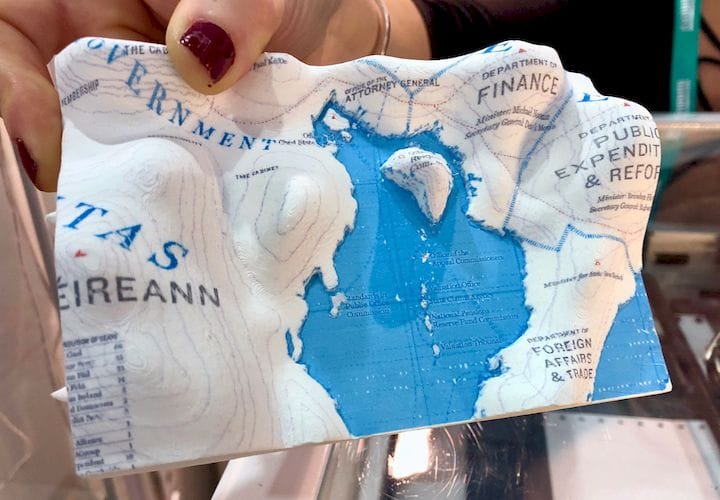
I’m looking at a new 3D print accessory project, PolyDye.
The concept is to transform an inexpensive desktop FFF 3D printer into one that can print in full colors. By “full”, I mean not switch colors, but print in any color at all, much like a 2D paper printer. This is color printing in a different way than you’d see on, say, a Bambu Lab printer with AMS. It’s not four colors – it’s ALL colors.
That may sound quite intriguing, but there are some challenges, as we will see.
How does PolyDye work? It’s essentially a mixup of a 2D inkjet printer and a 3D printer. The hardware is literally an inkjet print head, which is mounted on the 3D printer’s toolhead.
The inkjet printhead is mounted in a way that allows it to print colors on the current layer. If you printed a perfectly flat block, it could print on top of that block just like a piece of paper.
This allows a PolyDye-equipped 3D printer to print labeling on flat surfaces of a 3D print, and that is somewhat useful.
The more interesting use case is to use the inkjet to color the perimeters of the print. This introduces color to the exterior surface of the print, potentially on all layers from bottom to top.
In the images shown, you can see that it does indeed work. However, you’ll also notice that the colors seem a bit muted. This is a result of the thin layer of color ink on top of the extruded polymer; the colors are not fully opaque. As a result of this, the prints are not particularly vibrant. You’ll have to use a white filament, and the system likely works with most of the common 3D printed filament materials.

For software, you must use their web-based PolyPrint, as typical 3D print slicers don’t support full color. They support sets of colors, but not full color gamuts and certainly not gradients.
This is not surprising, as similar attempts to create inexpensive full color systems in the past have experienced much the same quality.

Here, for example, is a full-color 3D-printed dragon, made by XYZprinting’s da Vinci Color 3D printer back in 2018. The system used a reserve of CYMK inks and printed on the edges, just like PolyDye.

Another example is from the now-closed MCOR Technologies. They printed colored edges on standard white paper sheets, cut the perimeters, glued them together, and then pulled off the excess to reveal a full-color paper print. It worked, but again, the colors were quite muted.
Vibrant color technology is extremely complex, and in the world of 3D printing, only Mimaki and Stratasys have figured it out. However, both of their full-color solutions are quite expensive, especially compared to the PolyDye system.
Nevertheless, you can buy a PolyDye kit for only US$199 (on sale from US$250). However, they’re sold out at the moment. The kit includes all the parts required to modify the 3D printer to implement PolyDye, including three PCBs, a cartridge interface, cables, and more.
The company behind PolyDye, Level9000, said that PolyDye has been tested with the Creality CR6-SE and should be compatible with any desktop FFF device using Marlin and a USB port using certain chipsets.
The project has been open-sourced, and code is available on GitHub (you must use a modified version of the Marlin firmware).
Should you try PolyDye? If you’re into serious modifications to 3D printers and happen to own a compatible device, this could be an interesting experiment.
Just don’t expect full-color prints like you’d see from the high-end devices.
Via Level9000
